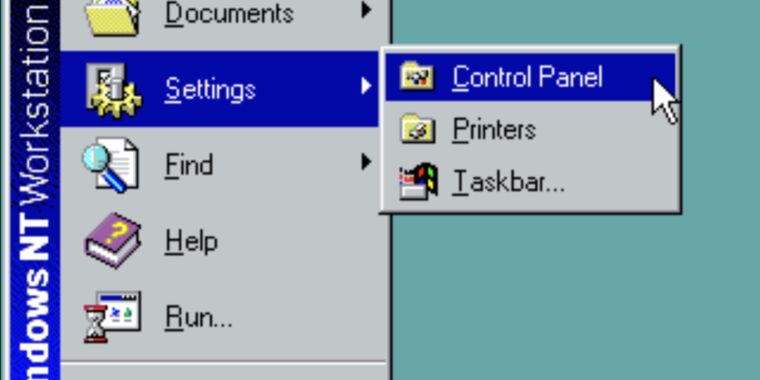-
Here you see the Windows NT 4.0 keyboard configuration screen.
Andrew Cunningham
-
Aside from some updated icons from the Windows Vista era, the design of the modern keyboard panel is identical.
Andrew Cunningham
-
The Mouse Pointers panel in Windows NT 4.
Andrew Cunningham
-
Once again, Windows 11 looks remarkably similar to the design from the old NT era.
Andrew Cunningham
-
The NT 4 Date and Time Configuration screen.
Andrew Cunningham
-
If you dig a few menus further down, you'll find a version of Date & Time that still looks very similar to its NT counterpart.
Andrew Cunningham
With an operating system as old as Windows, what Microsoft decides to remove is often just as (if not more) newsworthy as what it tries to add. You may or may not care about new AI-themed MS Paint additions or the soon-to-be-revived Recall feature, but you've almost certainly interacted with one of the Windows Control Panel applets at some point in the past 39 years. And according to a note buried on Microsoft's support site, those Control Panels' days may be numbered (emphasis ours):
“The Control Panel is a feature that has been part of Windows for a long time. It provides a central location to view and manipulate system settings and controls,” the support page explains. “Through a series of applets, you can adjust various options ranging from system time and date to hardware settings, network configurations, and more. The Control Panel is currently being replaced by the Settings app, which offers a more modern and streamlined experience.“
This won’t come as news to anyone who’s followed the evolution of Windows over the past decade or so. The Settings app was initially introduced in Windows 8 back in 2012 as a touchscreen-friendly alternative to some of the Control Panel applets, but over the course of Windows 10 it began to take on more and more Control Panel settings, and by the time Windows 11 came along, it was so full-featured that in most cases it could serve as a complete Control Panel replacement, with a handful of exceptions for particularly obscure tweaks (and for those who simply prefer the old ways).
But while individual Control Panel applets have disappeared over the years (the Displays pane, the Add/Remove Programs screen, panels for legacy features like Homegroups), Microsoft’s note suggests that the rest of the applets could disappear en masse in a future Windows update. That said, nothing is changing in Windows for a while. Even the upcoming 24H2 update still includes all the old Control Panels, and the gap between “deprecated” and “removed” could be years.
What’s incredible about some Control Panels right now is how far back some of their designs go. You’re never more than a double-click away from a piece of UI that’s essentially the exact same as it has been since 1996’s Windows NT 4.0, when Microsoft’s more stable NT operating system was revamped with the same user interface as Windows 95 (modern Windows is actually descended from NT, not 95 or 98). The Control Panel idea is even older, dating all the way back to Windows 1.0 in 1985.
Most of the Control Panel’s current design and iconography were laid down in Windows Vista and Windows 7 between 2006 and 2009, respectively, which explains why so many panels still have the rounded, glassy look that was synonymous with those versions of the operating system (just check out what the clock looks like in our screenshots above). It’s one of the few parts of the operating system that didn’t get a overhaul for Windows 11, which is arguably Microsoft’s most cohesive Windows design since 95 and NT 4.0; even long-standing apps like Paint and Notepad get a facelift, while other Windows 7-era holdovers like WordPad have been relegated to the background.

